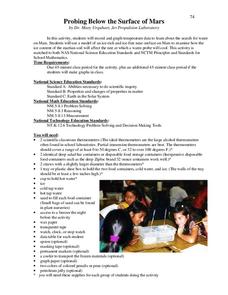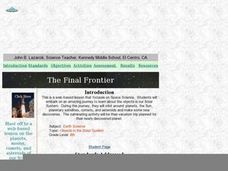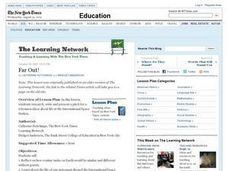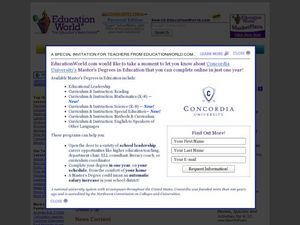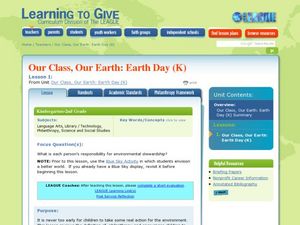Curated OER
Flight Paths of Orbiting Satellites
Students examine the path a satellite follows as it orbits the earth. In this space science instructional activity, students use a globe as they illustrate a satellite in its orbital plane, then plot points on the satellite's path on the...
Curated OER
A Moon with a View
Third graders explore the rotation of Earth and the moon. In this solar system lesson, 3rd graders participate in an Earth and moon simulation in which part of the class "becomes" the sun, while other children represent the moon by...
Curated OER
Meteorites
Students model how meteors fall to the surface of planets. In this space science lesson, students identify different types of meteorites using an interactive online website. They investigate the relationship between a meteorite's size...
Curated OER
Swinging on a Star
Students explore the issues that might arise if humans were to go on an interstellar space mission. They synthesize their understanding of interstellar travel by writing scenes from a science fiction novel that would depict such a mission.
Curated OER
Reflect on this Mote of Dust
Students explore space science by analyzing a speech by Carl Sagan. In this cosmos lesson plan, students view an online video of a speck of a "pale blue dot" in the distance of space which turns out to be Earth. Students write an essay...
Curated OER
Getting to Know Saturn: The Saturn System
Learners compare and contrast Earth and Saturn's planet features. In this space science lesson plan, students draw a diagram of the solar system and identify the different components. They complete a Saturn system scavenger hunt and Venn...
Curated OER
Solar Cycle
Students explore the solar cycle through a series of experiments. In this space science lesson, students construct and evaluate solar cycle graphs. They explain how this phenomenon affects the Earth.
Curated OER
Probing Below the Surface of Mars
Learners simulate the search for water in Mars using simple apparatus. For this space science lesson, students explain how soil temperature affects the cooling of probes. They graph the data collected from the simulation.
Curated OER
Impact Craters: Holes in the Ground!
Middle schoolers simulate crater formation through a lab activity. In this space science lesson, students calculate how much energy is transferred during meteorite impact. They identify different factors affecting the size and depth of...
Curated OER
Planets in Our Solar System
Second graders research climate and landforms on nine planets in our solar system, choose one planet to visit, gather information about their chosen planet's climate and landforms, and "invent" space suit that would enable them to...
Curated OER
Far Out!
Students research and compare/contrast how routine tasks on Earth would be without gravity. They read and discuss the article "The Life Galactic: A Lot of Work, a Little Play, Plenty of E-Mail." In groups they write a pitch for a TV...
Curated OER
We Are Lunar tics!
Second graders, working in cooperative groups, will create a multimedia presentation about the Earth's moon. Their research must be presented through three or more methods. (i.e. charts; graphs; oral reports; multi-media; dramatic role...
Curated OER
Rocks and Minerals
Students are able to describe earth processes (e.g., rusting, weathering, erosion) that have affected selected physical features in students, neighborhoods. They are able to identify various earth structures (e.g., mountains, faults,...
Curated OER
Hello Sun, Goodnight Moon
Students become familiar with different times around the world through the reading of 9 O'clock Lullaby. In this Earth, sun, moon lesson, students recognize the movement of the Earth and the relationship to the sun and the moon. ...
Curated OER
Searching for Meteorites
Students examine meteorites and attempt to recover meteorite fragments. In this space instructional activity students complete a demonstration on the impact of a meteorite using water balloons and make experimental predictions.
Curated OER
Teacher-Astronaut Offers New Lessons
Students read about teacher-in-space Barbara Morgan and life in space. In this space science and current event lesson, the teacher introduces the article with a vocabulary activity, then students read the news piece and participate in a...
Curated OER
Could the Solar System have Ten Planets?
Young scholars react to statements about the solar system, then read a news article about a recently discovered object that could be another planet. In this space science and current events lesson plan, the teacher introduces the lesson...
Curated OER
Chesapeake Scramble
In this environmental science worksheet, students identify the different animals that live and visit Chesapeake Bay by completing 6 word scrambles.
Curated OER
The Sun in Our Lives
Third graders identify the different parts of the sun. In this astronomy lesson plan, 3rd graders examine how the sun's energy drive life processes on Earth. They construct a model of a solar system using large rolls of toilet paper.
Curated OER
The Drake Equation
Students use the Drake Equation to calculate the probability of sustaining life on various planets. Through the use of the equation, they determine whether intelligent and advanced civilizations can be developed on planets other than...
Curated OER
Our Class, Our Earth day
Students understand the importance of participating in recycling and clean-up efforts in the community. In this recycling lesson, students respond to questions after reading "The Wartville Wizard" by Don Madden. Students articulate...
Curated OER
Rover Races
Students identify the challenges encountered by astronauts in operating a planetary rover. In this space science lesson plan, students create a rover using their team members. They follow a command sequence from the driver and navigate...
Curated OER
Black Holes Revealed
Students explore the concept of black holes through an interactive program. They explore how they form and what materials form them. They can also visit websites in which they can research radio transmission between the Earth and space.
Curated OER
Runaway Greenhouse Effect Exercise
Students role-play biologists, coal geologists, space warfare experts, astronomers, pollution-control scientists, and hydrophysicists as they answer the question, "Why is Venus so much hotter than the Earth?"
Other popular searches
- Space Science on Earth
- +Earth and Space Science
- Earth Space Science Quiz
- Inquiry Earth Space Science
- Earth and Space Sciences
- Science Earth and Space
- Earth Space Sciences
- Earth/space Science









